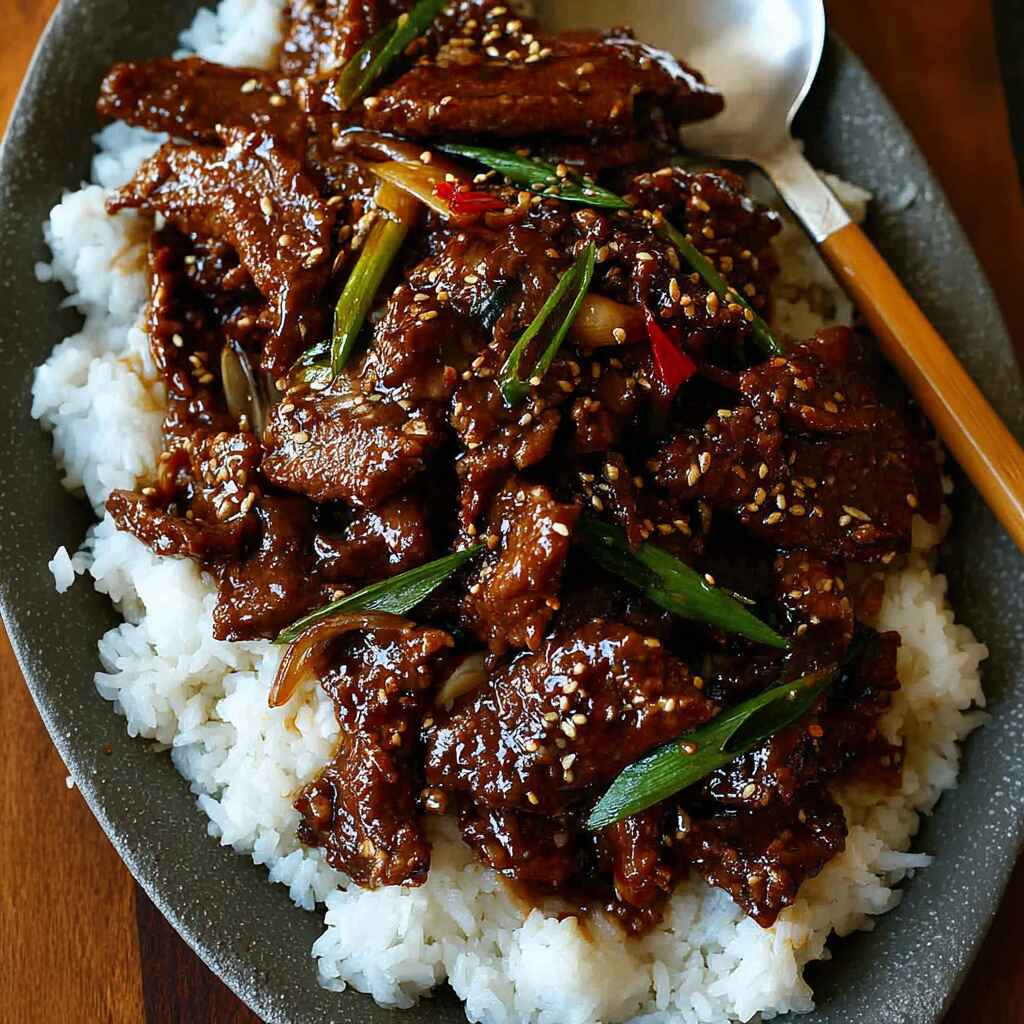There’s something frustrating about craving a restaurant-style dinner only to be left with greasy takeout and an empty wallet. Mongolian Beef is one of those dishes bold, saucy, tender but often delivered lukewarm in a plastic box. I used to think it was impossible to recreate that sticky-sweet glaze and sizzling sear at home without a commercial wok or secret soy sauce.
But then I remembered something my mother told me as we mixed soy and brown sugar in our kitchen in New Jersey: “The best meals come not from fancy tools, but from the hands that remember.”
FROM TAKEOUT TO TRADITION: HOW MONGOLIAN BEEF BECAME A FAMILY FIX
Years ago, after a long shift at the hospital, I brought home Mongolian Beef from a small halal Chinese takeout on the corner of Oakwood and 7th. It was our little reward after endless days. My son, sticky fingers and all, called it “sweet meat magic.” And so, the ritual began. Every Friday.
But the takeout bill grew taller, and the quality? Not so much.
So, one winter evening, I decided to recreate it. My version needed to be tender, boldly flavored. No guesswork, no hidden sauces. Just pantry staples, thin-sliced beef, garlic, and a little fire in the pan.
In our family kitchen, I cracked the code. And now, this isn’t just a dish it’s our Friday night memory, revived with every sizzle.
Here’s the thing: Mongolian Beef isn’t actually Mongolian in origin. It’s Chinese-American, rooted in Taiwanese-style barbecue. But names aside, it captures something deeper comfort in a bowl, fast enough for weeknights, special enough to share.
So whether you’re feeding little hands or hosting a big table, this recipe gives you that glossy, garlicky, just-spicy-enough bite that rivals any restaurant.
And trust me: once you make it this way, you won’t go back.
WHY THIS RECIPE WORKS SO WELL (AND YOU’LL NEVER MISS TAKEOUT AGAIN)
One of the biggest letdowns with homemade “takeout” is texture. Either the beef turns rubbery or the sauce ends up thin and forgettable. But this Mongolian Beef recipe solves that with three tried-and-true tricks that never fail.
When I first recreated this dish, I obsessed over that glossy, rich sauce. It needed to cling not drip and coat the beef like a velvet jacket. Turns out, the magic lives in a slurry-thickened brown sugar glaze, balanced by soy, garlic, and just enough ginger to tingle the tongue.
The second key? Flash-searing thin-sliced flank steak. Not stewing it. Not simmering it. Just high heat, fast hands, and a wok or skillet that’s smoking hot. This locks in the juiciness and gives you those coveted crispy edges without overcooking the center.
And finally, a tip from my mother’s spice drawer: a whisper of white pepper. It adds a quiet heat that dances on your palate without overwhelming it. It’s not traditional but it’s transformative.Cooking this dish feels almost… theatrical. The hiss of beef hitting the pan. The bubbling of sauce thickening like molasses. The way the aroma pulls everyone into the kitchen before you can even say “dinner’s ready.”
Once you try this, I promise: you’ll never settle for delivery again.
If sticky-sweet dinners are your thing, don’t miss our Garlic Parmesan Chicken and Pasta and this crowd-pleasing Chicken Burrito Bowl both perfect for weeknight wins.
INGREDIENTS, SUBSTITUTIONS & FOOLPROOF STEPS
This Mongolian Beef is rich, tender, and totally doable with pantry staples. You don’t need a wok (though it helps), and you definitely don’t need a culinary degree. Just a sharp knife, a hot pan, and a few essential tips.
Ingredients You’ll Need
- Flank steak – sliced very thin against the grain
- Cornstarch – helps crisp the beef and thicken the sauce
- Soy sauce – use low sodium for balance
- Dark brown sugar – gives the sauce its signature gloss and depth
- Garlic & fresh ginger – flavor bombs, don’t skip them
- Vegetable oil – neutral and ideal for high heat
- Water – to smooth out the sauce
- White pepper (optional) – for that subtle warmth
Ingredient Swaps
| Ingredient | Swap Option |
|---|---|
| Flank steak | Sirloin or flat iron steak |
| Cornstarch | Arrowroot powder |
| Soy sauce | Tamari (for gluten-free) |
| Dark brown sugar | Coconut sugar or maple syrup |
| White pepper | Black pepper or omit entirely |
Common Mistakes to Avoid
- Overcrowding the pan – cook in batches to get that sear
- Undercutting prep – slice beef while semi-frozen for thin, even strips
- Rushing the sauce – let it bubble to thicken properly
Pro Tips
- Freeze steak for 20 minutes before slicing it’s a game changer
- Prep sauce ingredients in a bowl before cooking saves stress
- Stir sauce constantly once it thickens to avoid burning
Nutrition Highlights
| Nutrient | Per Serving |
|---|---|
| Protein | 27g |
| Carbs | 22g |
| Fat | 14g |
Step-by-Step Instructions
- Slice the beef thinly against the grain and toss with cornstarch in a bowl. Let it rest 10 minutes.
- In a small bowl, whisk together soy sauce, brown sugar, water, garlic, and ginger.
- Heat oil in a large skillet or wok until shimmering hot. Sear beef in batches until browned and crispy. Set aside.
- In the same pan, pour in the sauce. Bring to a simmer and stir constantly.
- Return beef to the pan. Toss to coat in the thickened sauce. Sprinkle with white pepper if using.
- Serve hot over steamed rice, garnished with green onions or sesame seeds if desired.
Looking for another family-style winner? Try our One-Pot Ground Beef Stroganoff creamy, comforting, and mess-free.
SERVING, STORAGE & FREEZER TIPS
How to Serve Mongolian Beef
This dish is all about contrast tender beef, sticky sauce, fluffy rice. The best way to serve it? Over freshly steamed jasmine rice or garlic-fried rice for a little extra punch. Add a side of sautéed bok choy, snap peas, or a crisp cucumber salad to balance the richness.
For guests, I love plating it family-style on a large white platter sprinkled with scallions and toasted sesame seeds. It looks elegant, but feels like home.
If you’re packing lunchboxes or meal-prepping for the week, Mongolian Beef holds up beautifully. Just be sure to keep the rice and beef separate until reheating for best texture.
Our readers also love the quick and cozy Ground Beef and Rice Skillet for meal prep wins and the nostalgic Chicken Francese for dinner party flair.
How to Store
Let the beef cool completely before storing. Transfer leftovers to an airtight container and refrigerate for up to 4 days. The sauce may thicken slightly in the fridge but returns to its glossy self when reheated with a splash of water.
Reheat gently in a skillet over medium heat. Microwaving is okay in a pinch just cover loosely and stir halfway through.
Can You Freeze Mongolian Beef?
Yes, and it freezes surprisingly well!
Portion the cooled beef and sauce into freezer-safe bags or containers. Label and date, then freeze for up to 2 months.
To reheat: thaw overnight in the fridge and warm in a skillet. Avoid overcooking or the beef can get chewy.
For best results, freeze sauce and meat together but skip the rice. Cook fresh rice when serving for that just-made magic.
Want more freezer-friendly recipes? Don’t miss our Flank Steak Marinade and Crispy Baked Chicken Thighs.
FAQ: YOUR MONGOLIAN BEEF QUESTIONS ANSWERED
1. What is Mongolian beef made of?
Mongolian Beef is traditionally made with thinly sliced flank steak, lightly coated in cornstarch, then flash-seared to crisp the edges. The rich sauce is a blend of soy sauce, brown sugar, garlic, ginger, and water simple pantry staples that create a glossy, slightly sweet glaze.
What makes it irresistible is the balance: salty, sweet, a hint of heat, and that perfect chew in every bite.
2. Why do they call it Mongolian beef?
Despite the name, Mongolian Beef isn’t actually from Mongolia. It was popularized in Taiwan during the 1950s and later adapted by Chinese-American restaurants. The name likely refers to a “Mongolian barbecue” style of cooking rather than any specific Mongolian ingredients or traditions.
So while it may not be authentic to Mongolia, it’s absolutely authentic to the way comfort food evolves and travels across tables.
3. What is Mongolian beef supposed to taste like?
Think deep umami, a rich savory base kissed by brown sugar sweetness, rounded with garlic and ginger warmth. The texture of the beef should be crispy on the edges, tender in the middle, and coated in a velvety, glossy sauce that clings without being too sticky.
It’s the kind of flavor that lingers, in the best way.
4. What is Mongolian sauce made of?
Mongolian sauce is made from just a few ingredients: soy sauce (usually low sodium), dark brown sugar, fresh garlic, ginger, and water. The mixture is cooked until it thickens into a glossy glaze, often with the help of cornstarch as a natural thickener.
It’s bold, simple, and endlessly adaptable no complicated ingredients needed.
CONCLUSION: A DISH THAT STICKS TO YOUR SOUL
Mongolian Beef isn’t just dinner—it’s that moment when your kitchen smells better than any restaurant, when someone peeks in and says, “What smells so good?” It’s easy to make, wildly satisfying, and full of memory-making flavor.
Whether you’re chasing nostalgia or just trying something new, this recipe delivers every time.
YOU MAY ALSO LIKE
- One-Pot Ground Beef Stroganoff That’s Creamy, Easy & Mess-Free
- Garlic Parmesan Chicken and Pasta
- Chicken Burrito Bowl
Mongolian Beef
Ingredients
Equipment
Method
- Toss sliced flank steak with cornstarch until evenly coated. Let it rest for 10 minutes.
- Whisk together soy sauce, brown sugar, water, garlic, and ginger in a small bowl.
- Heat oil in a skillet over medium-high. Sear beef in batches until browned and crispy. Set aside.
- Pour sauce into the skillet. Bring to a simmer, stirring constantly until thickened.
- Return beef to the pan and toss to coat in the sauce. Serve hot over rice with green onions if desired.
Notes
If this recipe reminds you of someone you love, share it with them. Your memories keep recipes alive.
Recipe written by Jacqueline – from our kitchen to yours.

